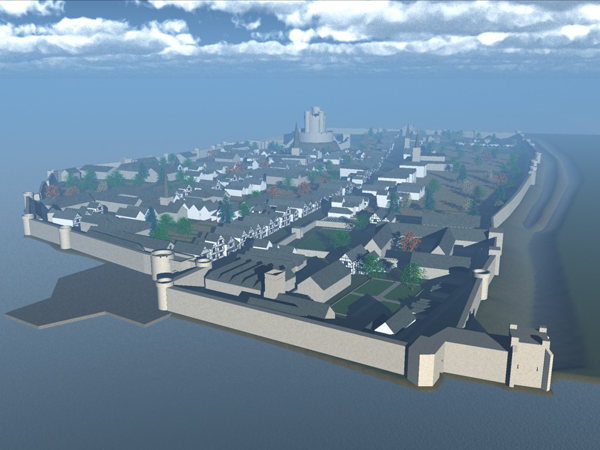Data Interpretation: Methods and Tools
Hypothesizing Southampton in 1454: A Three-dimensional Model of the Medieval Town
by Matt Jones
ABSTRACT
Three-dimensional modelling has an important role to play in the archaeological process. Computer Applications and Quantitative Methods in Archaeology (CAA) conferences and British Archaeological Reports (BAR) prove that a section of the archaeological community is validating the use of such models based on archaeological data. Barcélo claims that models should be embraced as they offer the means to represent features of concrete or abstract entities as opposed to mere illustrations that have been previously relied upon.1 Indeed 3D modelling offers a level of control and an ability to reconstruct past, built environments in an entirely new fashion. Inexpensive fully 3D environments can be built based upon factual data. However, their reception by academics is often frosty. One set of scholars claims ‘the appearance of an image or animation in a digital format out of context is nearly always misleading’.2
A lack of adequate documentation, auxiliary data and intellectual transparency lie at the root of this distrust of computer models. It is indeed misleading to present a model without providing the audience with the tools fully to understand the model and its limitations. This paper looks into the process of creating a 3D model of medieval Southampton based on disparate data sources, such as historical documents, map data and excavation data. It includes a discussion of the importance of being intellectually transparent, honest and informative at all stages of the model’s creation. When working with different data sources and, as is often the case with archaeology, an incomplete dataset, it is constantly necessary to make decisions. These decisions have a direct impact on the resulting hypothesis; in this case a computer-generated model of a medieval town of which only a fragment has survived. The methods employed in an attempt to add credibility to the model are presented and evaluated. These include how missing data and contrasting data were dealt with, recorded and presented alongside the actual model. It is important to make such intellectual transparency the rule rather than the exception to allow 3D digital modelling techniques to be fully embraced by the archaeological discipline.
Notes
1. Juan A. Barcélo, ‘Introduction’, in Juan A. Barceló, Maurizio Forte and Donald H. Sanders (eds), Virtual Reality in Archaeology, BAR International Series 843, (Oxford: Archaeopress, 2000): 9.
2. Geeske Bakker, Frans Meulenberg and Jan de Rode, ‘Truth and credibility as a double ambition: reconstruction of the built past, experiences and dilemmas’, Journal of Visualization and Computer Animation, 14/3 (2003): 159.



Pingback: Paradata and Transparency in Virtual Heritage | PARADATA
Very interesting. I would to follow up on your work Matt. Please keep in touch. David
Hi! Matt, loved it completely. I am interested in this, is it possible to speak with you over the phone lemme know. Write to me at amogh@lavabit.com.
Will wait for your mail.
Hi Matt,
Some great illustrations. Keep up the good work!
Nick
Hi Matt,
Cool project.
I was wondering if there was any chance you had a higher resolution version of the terrier map. I was hoping to include it in an essay of mine but all the ones online are rather low resolution so one cannot see the details. I’ve been having problems scanning the map directly from Platt’s book so hoped you might provide me with a version.
Thanks,
Ed
Hi Ed, thanks for your interest in Matt’s project. I hope he reads your post and gest back to you. Regrettably, I don’t have his current contacts details.
How about approaching Southampton Records for images of the original terrier (rather than relying on secondary sources)?
Good luck with your research, Anna